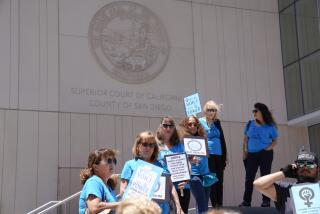Woman’s Death Spurs New Policy
Just 16 years old and pregnant, Veronica Daniel was frightened of her baby’s father.
He had kicked and even bitten her, leaving a 3-inch welt on her cheek. When sheriff’s deputies took him away one day in March 1996, Daniel promised her mother that she would move away before they let him out again.
But Daniel said she couldn’t get anyone at the Sheriff’s Department or the County Jail to tell her when Humberto Huelitl was getting out.
When he was released only five days into a 180-day sentence, it caught her by surprise. Huelitl came right to her family’s Rowland Heights apartment, where he killed Daniel, their unborn baby and a 2-year-old nephew before committing suicide.
On Tuesday--nearly 2 1/2 years after the slayings--Los Angeles County set up a program to notify domestic violence and stalking victims when the criminals who targeted them are released from jail or prison.
Under the program, to be administered by a Louisville, Ky., company that handles similar notification networks in 10 California counties and several states, victims who request information on the freeing of a batterer or stalker will be phoned when a release date is set, and within 10 minutes of an inmate’s departure from custody.
The program’s computers will call every 30 minutes for 24 hours if no one is home, and then follow up with a written letter. Victims, using a personal identification number issued by the Sheriff’s Department, can then call into a central database to find the exact date and time of the assailant’s release.
“This is the first proactive thing that L.A. County has done for victims of domestic violence and their children,” said victims’ rights advocate Maria Del Mar St. John, who brought Daniel’s story first to attorney Gloria Allred and, later, to county Supervisor Gloria Molina. “This is definitely going to help women.”
St. John, a former county lobbyist who became an advocate for battered women after her own marriage turned violent, said she knows firsthand the danger of not being aware when an offender is going to leave jail.
Her former husband, she said, was released early on misdemeanor spousal abuse charges and came looking for her at work, hiding behind her car in a underground parking lot in downtown Los Angeles.
“I didn’t see him until he popped up,” she recalled. “I started to run. . . . He said, ‘You’re my wife, and nobody is going to touch you except me.’ And then he raped me.”
St. John said she read about Daniel’s death in “a tiny article” in The Times and brought it to Allred’s attention.
St. John, Allred and Daniel’s mother appeared before the Board of Supervisors in April 1996, begging the county to institute a program to notify victims when their abusers or stalkers are released from custody.
The three also went to Sacramento, where they persuaded the Legislature to allow and encourage counties to adopt such programs.
Veronica’s mother, Reyna Daniel, said Tuesday that she did not wish to relive the tragedy by attending the Board of Supervisors meeting or discussing the case.
But Allred welcomed the news.
“It is unfortunate that it took the killing of a pregnant teenager to inspire this kind of program in L.A. County,” she said. “But at least she has not died in vain, in the sense that this will be of significant help to other victims.”
The program will be overseen by the Sheriff’s Department, which will supply information about the convicted abusers’ jail time, parole hearings and release dates, said department spokeswoman Elsa Avila.
The contractor, Vine Co., will indemnify the county against lawsuits that may arise if a victim is not properly notified and is later harmed by the assailant, Avila said.
Once the program is up and running--in 90 to 120 days, according to estimates--the Sheriff’s Department will contact victims of domestic abuse and stalking, and explain how to register.
Victims will be able to contact the system anonymously by phone.
The program was developed in Louisville after a woman named Mary Byron was murdered on her 21st birthday by a former boyfriend who had been released on bail. It is now used by 150 counties in 12 states.
More to Read
Sign up for Essential California
The most important California stories and recommendations in your inbox every morning.
You may occasionally receive promotional content from the Los Angeles Times.










